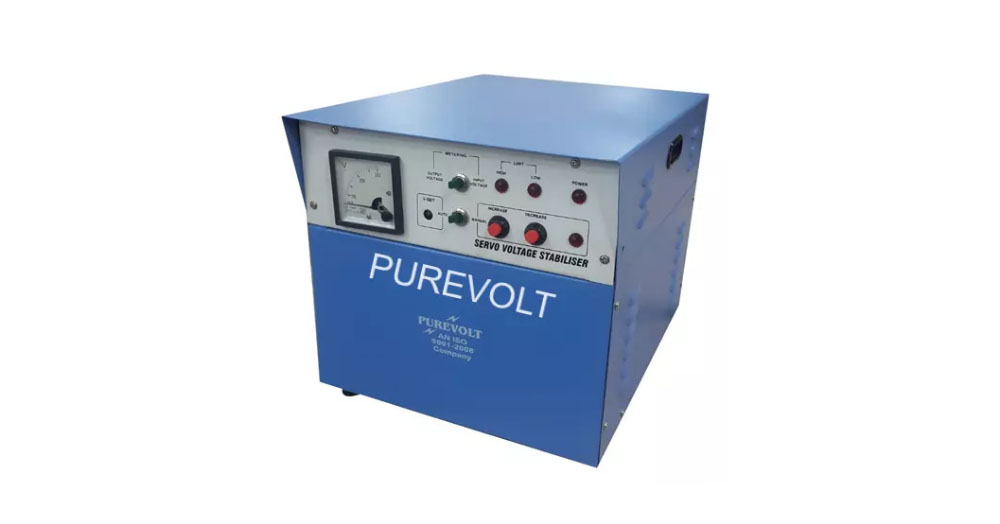Introduction
Choosing the right servo stabilizer is crucial for the health of your devices. In this article, we will get into the details of how to pick the right servo stabilizer.
Key factors to consider before choosing a servo stabilizer:
Voltage Fluctuation Range:
First of all, find the voltage range in your area. Your voltage stabilizer must be able to handle both the maximum and minimum voltage levels in your area.
If the stabilizer fails to regulate the range of voltage in your area, it will adversely impact the longevity of your device or could cause permanent damage.
Load Capacity:
Measure the loading capacity of all your equipment and devices before connecting them to the stabilizer.
Make sure the stabilizer you are using always has a higher capacity than the total load capacity of your devices.
Higher means it should at least be slightly higher than the total load capacity of your devices.
Number of Phases:
Find out whether your electrical system operates in a single-phase or three-phase configuration.
You cannot use a single-phase stabilizer in a three-phase electrical system, and vice versa.
You must buy a stabilizer that matches up with the number of phases in your electrical system.
Response Time:
In the event of a sudden surge or drop in voltage level or volatile voltage fluctuation, the servo stabilizer must be equipped to provide a quick response.
A slower response from the servo stabilizer may cause permanent damage to your sensitive device or reduce its lifespan.
It is always advisable to buy a servo stabilizer with fast response timing.
Efficiency:
You must test the stabilizer for its efficiency before buying it. High-efficiency servo stabilizers reduce energy waste and operate at lower costs, thus giving a high ROI in the long run.
Build Quality and Durability:
The material used for building the servo stabilizer must be of high quality, strong, and durable. This will assure two things in your servo stabilizer.
One high-quality build-up assures the long life span of your stabilizer. Second, it also ensures the reliable performance of the stabilizer.
Mounting Type:
Decide on the type of mounting you require for your devices. Stabilizers come in all forms of mounting.
Stabilizers could be wall-mounted or floor-mounted based on the available space and requirements of installation.
Display and Monitoring Features:
Pick stabilizers with clear displays and monitoring features. This will give you a clear idea of the voltage range, load status, low voltage, high voltage, and other important information.
Safety Features:
Safety features are for your and your device’s safety. It will protect you from overload, short circuits, and overheating.
Stabilizers without safety features easily get damaged and damage your devices.
Brand Reputation and Warranty:
Check Google reviews and reviews from other platforms before making a buying decision.
Ratings and reviews help you estimate the brand value of stabilizers.
Stabilizers with higher ratings and reviews have a higher brand reputation.
Products with high brand value have to live up to their reputation and, hence, offer the best quality products.
Also, consider the warranty duration of the stabilizer. The warranty will ensure post-sales services and customer support in case of troubleshooting, maintenance, or operating the stabilizer.
Environmental Conditions:
What setup do you have for the installation of the stabilizer? If the environment is harsh, does it need some special protection or insulation or not?
Exactly where will you install the stabilizer? What size of stabilizer do you require, depending on the space available?
Consider all these aspects before making a buying decision.
Budget:
Last but not least, your budget is also an important factor to consider before buying a servo stabilizer.
We are mentioning this factor last because your requirements, features, and quality of the servo stabilizer are more important than the cost of the stabilizer.
Stabilizers with high quality and better features are more expensive than low-quality products.
Also, stabilizers with a high reputation will come at a high price due to their brand value.
Try to pick a servo stabilizer with high quality and a reasonable price that fits your requirements.
Conclusion:
Buying the right servo stabilizer depends on factors like the voltage fluctuation range, load capacity, number of phases, response time, efficiency, build quality, and durability.
Also, factors like mounting type, display, monitoring features, safety features, brand reputation, warranty, environmental conditions, and budget are important to consider before purchasing a servo stabilizer.
Features, quality, and price differ from stabilizer to stabilizer.
Try to balance your choice with system requirements, the quality of the stabilizer, and its price.

